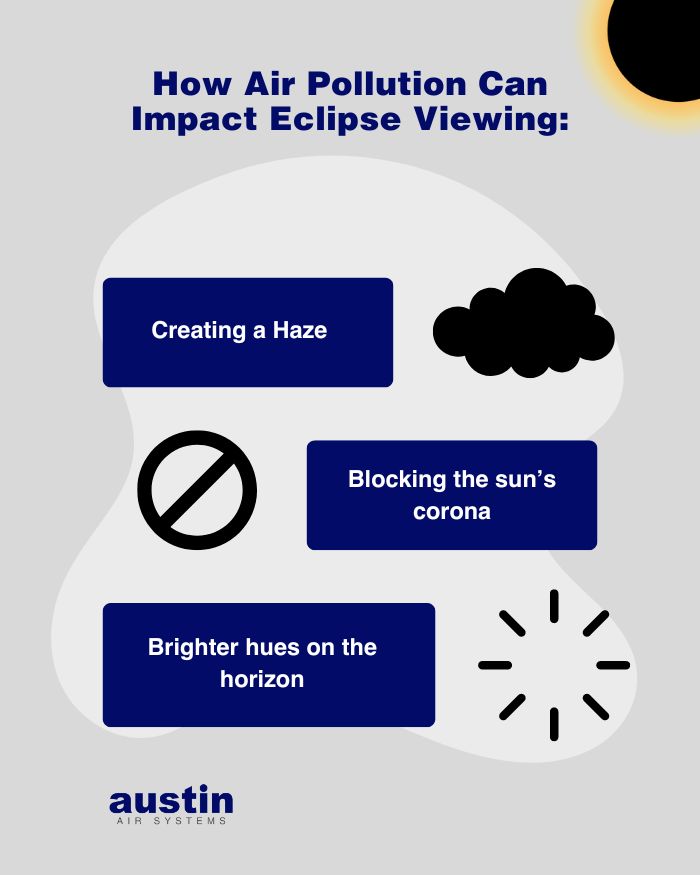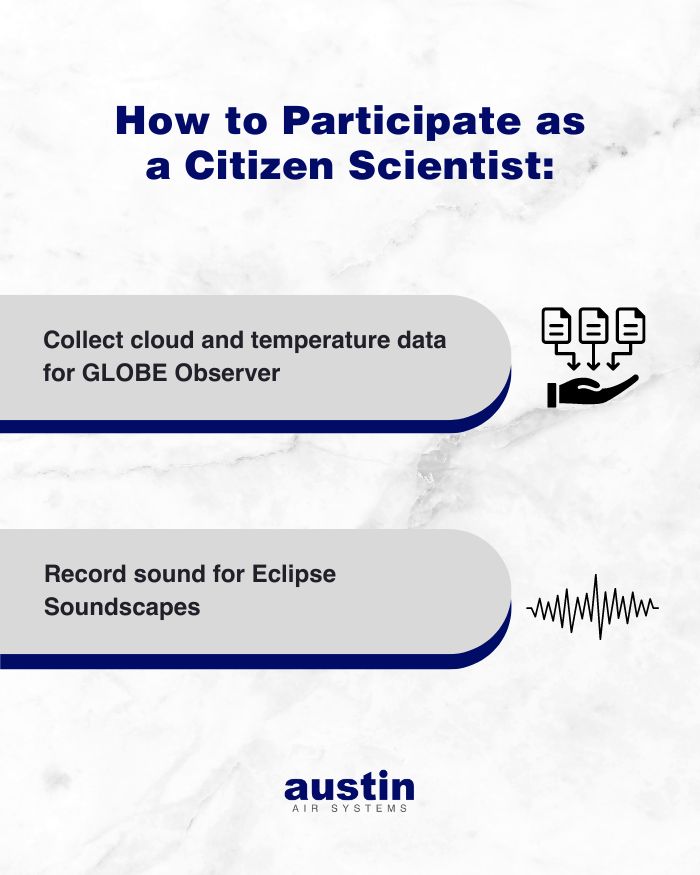On Monday, April 8, a celestial ballet will bring together the sun, the moon, and the Earth in a mesmerizing display a.k.a. a total solar eclipse. What’s extra exciting about this particular eclipse is that it’ll happen over large areas of land, instead of out over the ocean, with a sizable population that can enjoy totality.
We’re not just yakking about “celestial ballet” because we’re based in Buffalo, New York and in the path of totality. This year, almost every part of the continental United States will experience a partial solar eclipse. It will be worth checking out just about everywhere, in fact a lot of schools will be closing early or offering excused absences.
Another actor will also join the celestial stage – air pollution, which will have a unique interaction with the total solar eclipse, because each impacts the other in profound ways. In this article, we delve into how air pollution affects the experience of witnessing a total solar eclipse and how the eclipse, in turn, influences air pollution levels.
We’ll also tell you how to partake as a citizen scientist during the eclipse, contributing data to a temperature and cloud study or a massive soundscape study taking place, to make you an active participant in this historic event.
Can Air Pollution Affect How We See A Solar Eclipse?
Air pollution, primarily composed of particulate matter and aerosols, plays a significant role in altering the appearance of the sky on any given day and in a particularly powerful manner during a total solar eclipse. Pollutants scatter and absorb sunlight, leading to changes in atmospheric transparency (causing a haze) and color.
One of the leading spectacles of a total solar eclipse is the ability to see the sun’s corona. It is the outermost layer of the sun’s atmosphere, extending millions of kilometers into space. The corona consists of extremely hot, ionized gas and is only visible to the naked eye during a total solar eclipse – where it looks like a faint, glowing halo surrounding the darkened disk of the moon.
Particulate matter can create a haze in the atmosphere, diminishing the contrast between the darkened sky and the solar corona, thereby detracting from the awe-inspiring spectacle that observers can only enjoy during this rare event.1
The presence of pollutants can also dull the brilliance of the sun’s corona, reducing its visibility during the eclipse’s totality. This is reported to have been the case with the 2015 eclipse in the UK.
Another phenomenon that is impacted by air pollution which takes place during a solar eclipse is the 360-degree sunrise/sunset effect. Cast your eyes towards the horizon during totality and you will be treated to the surrounding hues of sunrise and sunset in all directions. It arises from sunlight diffusing across regions beyond the path of totality and persists only for the duration of the moon fully obscuring the sun.2 These hues can be impacted by air pollution – with aerosols creating richer red hues than there would be without the added pollution.3

The Measurable Impact of Total Solar Eclipses on Air Pollution
Solar eclipses present precious opportunities for scientific exploration, with one of the most significant examples being the confirmation of Einstein’s general theory of relativity – which was done during an eclipse on a remote island way back in 1919.45 To this day, total solar eclipses exert an intriguing influence on other natural phenomena, including air pollution.6
During an eclipse, the abrupt reduction in solar radiation triggers a rapid cooling of the Earth’s surface and atmosphere. This sudden temperature drop disrupts atmospheric stability, leading to changes in air circulation patterns and pollutant dispersion.7 One notable effect is the suppression of photochemical reactions that contribute to the formation of ground-level ozone, a harmful air pollutant.8 The decrease in solar radiation during the eclipse reduces the energy available for these reactions, resulting in a temporary decline in ozone concentrations.
Additionally, the decrease in temperature may enhance atmospheric mixing, facilitating the dispersion of pollutants and improving air quality in the vicinity of the eclipse path.
However, the influence of a total solar eclipse on air pollution is transient, lasting only for the duration of the event and its immediate aftermath. As the sun re-emerges and normal solar radiation resumes, atmospheric conditions quickly revert to their pre-eclipse state.
How You Can Participate as a Citizen Scientist During the Eclipse 2024
During the solar eclipse of 2024 you can join in the collection of scientific data! You can help crowdsource some NASA research by providing cloud/temperature data with the GLOBE Eclipse Challenge: Clouds and Our Solar-Powered Earth or submitting sound recordings to Eclipse Soundscapes (ES) Project – an informal education project mapping animal responses to the sudden darkness of an eclipse.
Volunteer as a citizen scientist and supply temperature/cloud data or sound recordings as a hands-on way to engage with science and nature.9 Rather than passively observing the eclipse, you actively contribute to scientific data collection, enhancing your sense of connection to the natural world and fostering a greater appreciation for the beauty and complexity of the Earth’s atmosphere.
All data will help researchers better understand atmospheric dynamics and climate processes, ultimately leading to advancements in our understanding of Earth’s system. Getting involved will allow you to contribute to scientific research – something most of us don’t get to do often, if ever. Participating in either project will also connect you with a diverse community of citizen scientists from around the world.
Just download the GLOBE Observer App for Apple or Android. (Thermometers are not included and the temperature from your weather app is from a station that may be unreliable due to distance.) You don’t need any equipment beyond your smartphone to participate in the Eclipse Soundscapes project.

Exposing Instead of Eclipsing
The relationship between air pollution and total solar eclipses underscores the intricate connections between human activities and natural phenomena. While air pollution can diminish the spectacle of a total solar eclipse, the eclipse itself offers a fleeting reprieve from certain pollutants, albeit with limited and temporary effects.
Events like total solar eclipses serve as poignant reminders of the delicate balance between humanity and the natural world. By contributing simple scientific data to large-scale community projects, we can have an impact that will be felt by future generations.
If the eclipse makes it clear to you that air pollution is a problem where you live, work, or play (by making a hazy corona or violently red sunset-looking sky), consider any member of the Austin Air line of air purifiers as a solution.
REFERENCES
1 Air Pollution & Visibility – Air. (2020 July 22). U.S. National Park Service. https://www.nps.gov/subjects/air/visibility.htm.
2 Lada, B. (2024, March 28). 5 surprising effects the 2024 total solar eclipse will have on animals and the weather. AccuWeather. https://www.accuweather.com/en/solar-eclipse-2024/5-surprising-effects-the-2024-total-solar-eclipse-will-have-on-animals-and-the-weather/1613153.
3 Ballantyne, C. (2024, February 20). Fact or Fiction?: Smog Creates Beautiful Sunsets. Scientific American. https://www.scientificamerican.com/article/fact-or-fiction-smog-creates-beautiful-sunsets/.
4 Einstein announces the general theory of relativity. (n.d.). A Science Odyssey: People and Discoveries. https://www.pbs.org/wgbh/aso/databank/entries/dp15ei.html.
5 Dyson FW, Eddington AS, Davidson C. (1919 November 6). A Determination of the Deflection of Light by the sun’s Gravitational Field, from Observations Made at the Total Eclipse of May 29, 1919. Phil Trans of the Roy Soc of Lon, Vol 220 (1920), pp 291-333. https://www.jstor.org/stable/91137.
6 Jokinen T, Kontkanen J, Lehtipalo K, et al. Solar eclipse demonstrating the importance of photochemistry in new particle formation. Sci Rep 7, 45707 (2017). doi: 10.1038/srep45707.
7 Jain, CD, Ratnam, MV, & Madhavan, B. (2020, December 1). Direct and indirect photochemical impacts on the trace gases observed during the solar eclipse over a tropical rural location. Journal of Atmospheric and Solar-terrestrial Physics. doi: 10.1016/j.jastp.2020.105451.
8 Tian Y, Li J, Yang, C, et al. (2022, August 29). Effects of the annular eclipse on the surface O3 in yunnan province, China. Frontiers in Environmental Science. doi: 10.3389/fenvs.2022.968507.
9 Chung YS, Kim HS, Choo SH. (2010 January 8) The solar eclipse and associated atmospheric variations observed in South Korea on 22 July 2009. Air Qual Atmos Health. 2010 Sep;3(3):125-130. doi: 10.1007/s11869-009-0060-0.
